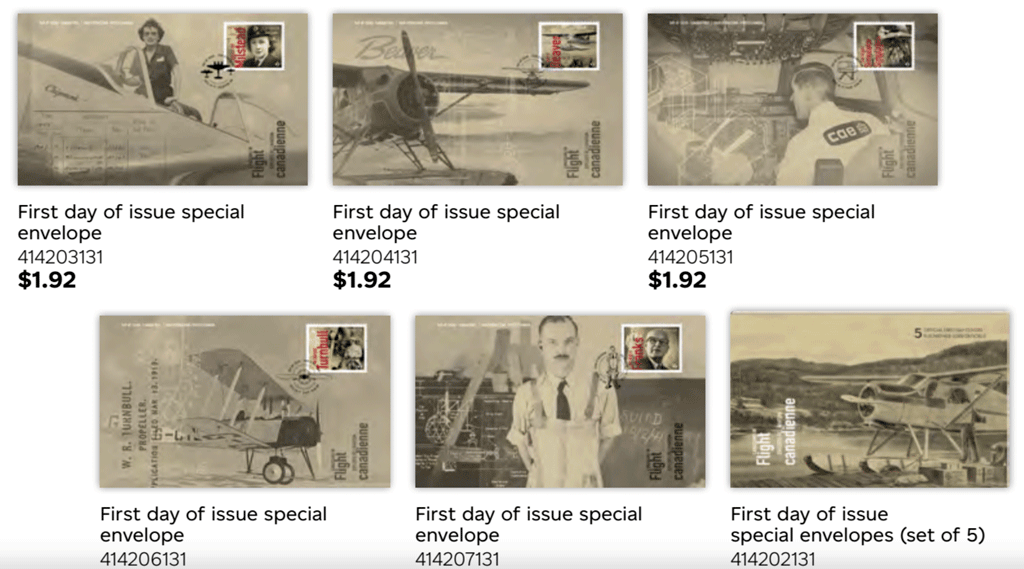Canadians in Flight
Issue date: October 17, 2022
First posted: October 6th. Newest information is above the line.
Scott catalogue numbers:
- Souvenir sheet of 5 + label: Sc. 3355
- Violet Milstead, Sc. 3355a, 3356 booklet single
- De Havilland aircraft. Sc. 3355b, 3359 booklet single
- CAE Flight Simulator, Sc. 3355c, 3360 booklet single
- Dr. Wilbur R. Frank, Sc. 3355d, 3357 booklet single
- W. Rupert Turnbull, 3355e, 3358 booklet single
Updated October 23:
[press release] [click on any of the pictures for larger versions]
Canadians in Flight stamps celebrate leadership in aviation and aeronautics technology, innovation
Five-stamp set commemorates groundbreaking female pilot, legendary bush plane and three innovators who changed aviation
OTTAWA – Canada Post released the second instalment of its Canadians in Flight stamps today, an issue that celebrates the people, planes and technology that have allowed Canada’s reputation for innovation to soar.
Developed with the support of Canada’s Aviation Hall of Fame, the Canada Aviation and Space Museum, as well as the Ottawa chapter of the Canadian Aviation Historical Society, this edition of Canadians in Flight honours these achievements:
- Violet (Vi) Milstead (1919-2014). One of Canada’s first female bush pilots, Toronto-
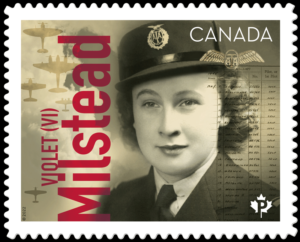 born Vi Milstead instructed at Toronto’s Barker Field before signing up with Britain’s Air Transport Auxiliary during the Second World War. The civilian organization ferried military aircraft between factories and front-line squadrons. Over 28 months, Milstead logged more than 600 hours in 47 types of aircraft, including massive, multi-engine bombers. Following the war, she moved to Sudbury, Ont., where she flew as a bush pilot and also instructed.
born Vi Milstead instructed at Toronto’s Barker Field before signing up with Britain’s Air Transport Auxiliary during the Second World War. The civilian organization ferried military aircraft between factories and front-line squadrons. Over 28 months, Milstead logged more than 600 hours in 47 types of aircraft, including massive, multi-engine bombers. Following the war, she moved to Sudbury, Ont., where she flew as a bush pilot and also instructed. - The de Havilland Canada DHC-2 Beaver. The Beaver is considered the best
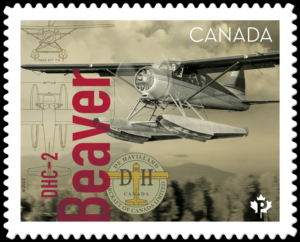 bush plane ever built and was named one of Canada’s top 10 engineering achievements of the 20th century. The all-metal plane’s short takeoff and landing capability – along with its ability to be fitted with wheels, floats or skis – made the Beaver ideal for accessing and connecting remote areas of the country.
bush plane ever built and was named one of Canada’s top 10 engineering achievements of the 20th century. The all-metal plane’s short takeoff and landing capability – along with its ability to be fitted with wheels, floats or skis – made the Beaver ideal for accessing and connecting remote areas of the country. - Kenneth Patrick (1915-2002) and the CAE flight simulator.
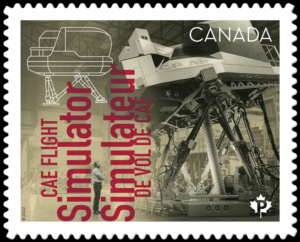 New Brunswick’s Kenneth Patrick, a former Royal Canadian Air Force officer, introduced simulator technology to Canada through CAE Inc. (then Canadian Aviation Electronics Ltd.), the company he founded in 1947. By the 1980s, CAE had developed a simulator so realistic it was no longer necessary for all flight training to be completed on actual aircraft. Today, air travel is the safest mode of transportation in part because commercial pilots train in simulators – most produced by CAE Inc.
New Brunswick’s Kenneth Patrick, a former Royal Canadian Air Force officer, introduced simulator technology to Canada through CAE Inc. (then Canadian Aviation Electronics Ltd.), the company he founded in 1947. By the 1980s, CAE had developed a simulator so realistic it was no longer necessary for all flight training to be completed on actual aircraft. Today, air travel is the safest mode of transportation in part because commercial pilots train in simulators – most produced by CAE Inc. - Wallace Rupert Turnbull (1870-1954) and the variable pitch propeller. This
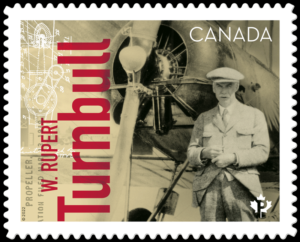 Saint John, N.B., native was a pioneering aeronautical engineer who developed the variable pitch propeller. The device allowed pilots to adjust the pitch, or angle, of propeller blades in flight as easily as one would change gears in a manual car. This improved the aircraft’s efficiency.
Saint John, N.B., native was a pioneering aeronautical engineer who developed the variable pitch propeller. The device allowed pilots to adjust the pitch, or angle, of propeller blades in flight as easily as one would change gears in a manual car. This improved the aircraft’s efficiency. - Wilbur R. Franks (1901-86) and the G-suit. Dr. Franks,
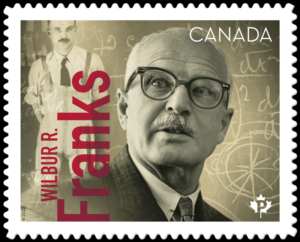 born in Weston, Ont., developed the world’s first anti-gravity suit used in combat, during the Second World War. The rubber suit, which he personally tested and was also known as the Franks Flying Suit, was lined with water-filled pockets that created enough hydrostatic pressure to counter strong gravitational (G) forces.These global advances provided the foundation for ongoing improvements in aviation and remain an important part of Canadian history.
born in Weston, Ont., developed the world’s first anti-gravity suit used in combat, during the Second World War. The rubber suit, which he personally tested and was also known as the Franks Flying Suit, was lined with water-filled pockets that created enough hydrostatic pressure to counter strong gravitational (G) forces.These global advances provided the foundation for ongoing improvements in aviation and remain an important part of Canadian history.
The stamp issue, designed by Ivan Novotny of TaylorISprules Corporation and printed by Lowe-Martin, is available in a booklet of 10 PermanentTMdomestic rate stamps (two of each design) and a gummed mini-pane of five. A limited number of framed panes and five Official First Day Covers are also available as a set or separately.
The first five stamps were issued in 2019.
Technical Specifications: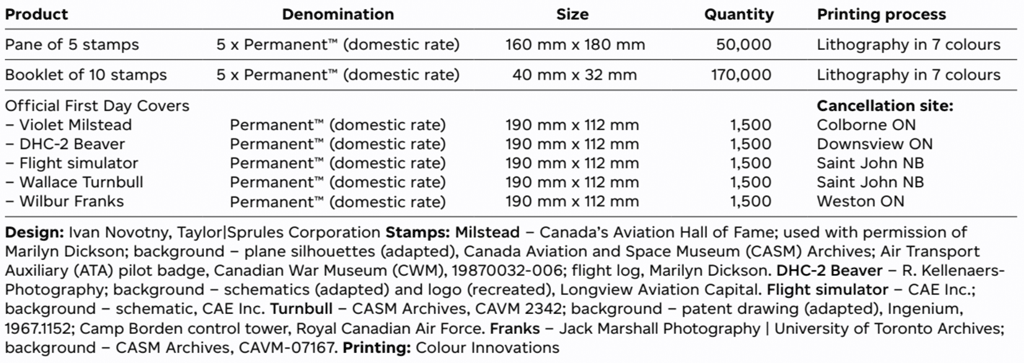 [en Francais pour les médias d’information]
[en Francais pour les médias d’information]
La série de timbres Exploits de l’aviation canadienne salue les réalisations du pays dans le monde de l’aviation
Le jeu de cinq timbres souligne l’importante contribution d’une pilote avant-gardiste, d’un avion de brousse légendaire et de trois inventeurs à l’histoire de l’aéronautique
OTTAWA – Aujourd’hui, Postes Canada a lancé le deuxième volet de sa série Exploits de l’aviation canadienne. Cette émission célèbre des personnes, un aéronef et des avancées technologiques qui, par leur caractère novateur, ont permis au Canada de se bâtir une réputation de visionnaire.
Conçus en collaboration avec le Panthéon de l’aviation du Canada, le Musée de l’aviation et de l’espace du Canada et la section d’Ottawa de la Canadian Aviation Historical Society, ces timbres rendent hommage aux réalisations suivantes :
- Violet (Vi) Milstead (1919-2014). Née à Toronto, Vi Milstead est l’une des
 premières pilotes de brousse au Canada. Instructrice au Barker Field de Toronto, elle se joint à l’organisation britannique Air Transport Auxiliary pendant la Seconde Guerre mondiale. Au cours de ses 28 mois en Grande-Bretagne, elle transporte des aéronefs militaires entre les usines et les escadrons de première ligne, effectue plus de 600 heures de vol et pilote 47 types d’aéronefs, comme de gros bombardiers multimoteurs. Après la guerre, elle s’installe à Sudbury, en Ontario, où elle enseigne et vole à titre de pilote de brousse.
premières pilotes de brousse au Canada. Instructrice au Barker Field de Toronto, elle se joint à l’organisation britannique Air Transport Auxiliary pendant la Seconde Guerre mondiale. Au cours de ses 28 mois en Grande-Bretagne, elle transporte des aéronefs militaires entre les usines et les escadrons de première ligne, effectue plus de 600 heures de vol et pilote 47 types d’aéronefs, comme de gros bombardiers multimoteurs. Après la guerre, elle s’installe à Sudbury, en Ontario, où elle enseigne et vole à titre de pilote de brousse. - Le DHC-2 Beaver de la compagnie de Havilland Canada. Considéré comme le
 meilleur avion de brousse jamais construit, le Beaver est désigné comme l’une des 10 plus grandes réalisations d’ingénierie canadiennes du 20e siècle. L’aéronef entièrement fait de métal est capable de décoller et d’atterrir sur de courtes distances, et on peut l’équiper de roues, de flotteurs ou de skis, ce qui en fait l’appareil idéal pour se rendre dans les régions éloignées du Canada.
meilleur avion de brousse jamais construit, le Beaver est désigné comme l’une des 10 plus grandes réalisations d’ingénierie canadiennes du 20e siècle. L’aéronef entièrement fait de métal est capable de décoller et d’atterrir sur de courtes distances, et on peut l’équiper de roues, de flotteurs ou de skis, ce qui en fait l’appareil idéal pour se rendre dans les régions éloignées du Canada. - Kenneth Patrick (1915-2002) et le simulateur de vol de CAE. Kenneth Patrick,
 ancien officier de l’Aviation royale canadienne originaire du Nouveau-Brunswick, introduit la technologie de simulateur de vol au Canada avec CAE Inc., l’entreprise qu’il fonde en 1947 et qui s’appelle à l’époque Canadian Aviation Electronics Ltd. Dans les années 1980, l’entreprise met au point un simulateur de vol si réaliste que les pilotes n’ont plus à suivre toute leur formation à bord de véritables aéronefs. Si l’avion est aujourd’hui le mode de transport le plus sécuritaire, c’est en partie dû au fait que les pilotes professionnels s’entraînent sur des simulateurs de vol, la plupart produits par CAE Inc.
ancien officier de l’Aviation royale canadienne originaire du Nouveau-Brunswick, introduit la technologie de simulateur de vol au Canada avec CAE Inc., l’entreprise qu’il fonde en 1947 et qui s’appelle à l’époque Canadian Aviation Electronics Ltd. Dans les années 1980, l’entreprise met au point un simulateur de vol si réaliste que les pilotes n’ont plus à suivre toute leur formation à bord de véritables aéronefs. Si l’avion est aujourd’hui le mode de transport le plus sécuritaire, c’est en partie dû au fait que les pilotes professionnels s’entraînent sur des simulateurs de vol, la plupart produits par CAE Inc. - Wallace Rupert Turnbull (1870-1954) et l’hélice à pas variable. Né à Saint
 John, au Nouveau-Brunswick, ce pionnier de l’ingénierie aéronautique est l’inventeur de l’hélice à pas variable. Cette invention améliore l’efficacité de l’aéronef en permettant aux pilotes d’ajuster l’angle, c’est à dire le pas, des pales pendant le vol, ce qui équivaut à changer de vitesse dans une voiture.
John, au Nouveau-Brunswick, ce pionnier de l’ingénierie aéronautique est l’inventeur de l’hélice à pas variable. Cette invention améliore l’efficacité de l’aéronef en permettant aux pilotes d’ajuster l’angle, c’est à dire le pas, des pales pendant le vol, ce qui équivaut à changer de vitesse dans une voiture. - Wilbur R. Franks (1901-1986) et la combinaison anti-g. Né
 à Weston, en Ontario, le Dr Franks met au point la première combinaison anti-gravité utilisée au combat pendant la Seconde Guerre mondiale. Il teste personnellement sa création, que l’on appelle aussi la combinaison de vol Franks. Faite de caoutchouc, elle est doublée de poches remplies d’eau, créant une pression hydrostatique suffisante pour contrer les forces g.
à Weston, en Ontario, le Dr Franks met au point la première combinaison anti-gravité utilisée au combat pendant la Seconde Guerre mondiale. Il teste personnellement sa création, que l’on appelle aussi la combinaison de vol Franks. Faite de caoutchouc, elle est doublée de poches remplies d’eau, créant une pression hydrostatique suffisante pour contrer les forces g.
Ces avancées mondiales ont contribué aux progrès continus dans le domaine de l’aviation et continuent d’occuper une place importante dans l’histoire du Canada.
Les timbres, conçus par Ivan Novotny de Taylor|Sprules et imprimés par le groupe Lowe-Martin, sont offerts en carnet de 10 timbres PermanentsMC au tarif du régime intérieur (deux de chaque motif) et en mini-feuillet de cinq timbres gommés. Un nombre limité de feuillets encadrés et cinq plis Premier Jour officiels sont également offerts ensemble ou séparément.
Les cinq premiers timbres de la série ont été émis en 2019.
[from Details] [click on any of the pictures for larger versions]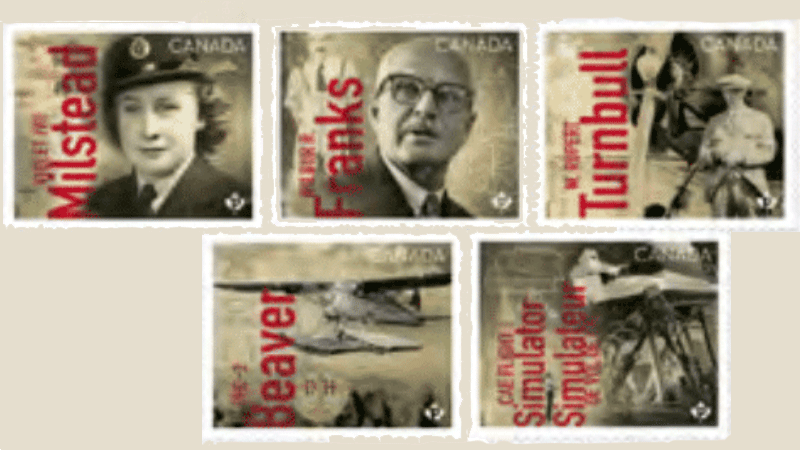 Ready for take-off on its return trip, the second edition of Canadians in Flight once again celebrates the people, planes and technologies that have allowed Canada’s reputation for innovation to soar. Since the early days of flight, Canadians have made global advances in the fields of aviation and aeronautics, with some contributions remaining the foundation for ongoing advancement in these fields.
Ready for take-off on its return trip, the second edition of Canadians in Flight once again celebrates the people, planes and technologies that have allowed Canada’s reputation for innovation to soar. Since the early days of flight, Canadians have made global advances in the fields of aviation and aeronautics, with some contributions remaining the foundation for ongoing advancement in these fields.
One of Canada’s first female bush pilots, Toronto-born Violet (Vi) Milstead (1919-2014) earned her private pilot’s licence in 1939, followed by her commercial licence and instructor’s rating, and taught at Toronto’s Barker Field. During the Second World War, she joined Britain’s Air Transport Auxiliary, ferrying military aircraft – everything from single-engined fighters to large multi-engined bombers – between the factories and frontline squadrons. After the war, she married and moved to Sudbury, instructing and flying as a bush pilot.
The de Havilland Canada DHC-2 Beaver made its first flight on August 16, 1947, and by the time production ended in 1968, the company had produced 1,692 of the bush planes, delivered to 62 countries. With its short take-off and landing capability, flexibility to be fitted with wheels, floats or skis, and ability to carry up to nine passengers or bulk cargo, the Beaver is considered the best bush plane ever built. The Engineering Centennial Board named it one of Canada’s top ten engineering achievements of the 20th century.
Pilots around the world can thank Canadian flight-simulator technology for their highly specialized training. Former Royal Canadian Air Force officer Kenneth Patrick (1915-2002) brought the technology to Canada through CAE Inc. (then Canadian Aviation Electronics Ltd.) – the company he founded in 1947. CAE built its first flight simulator in the early 1950s 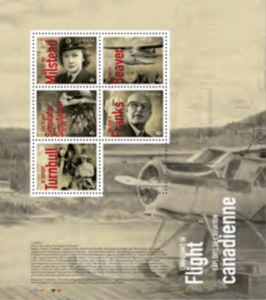 and by the early 1980s had developed a flight simulator so realistic that it was no longer necessary for all flight training to be completed on an actual aircraft.
and by the early 1980s had developed a flight simulator so realistic that it was no longer necessary for all flight training to be completed on an actual aircraft.
Born in Saint John, New Brunswick, pioneering aeronautical engineer Wallace Rupert Turnbull (1870-1954) built Canada’s first wind tunnel in 1902 and spent the next decade researching aircraft stability and airfoils and experimenting with lift devices, internal combustion engines, turbines and hydroplanes. His most notable achievement, the variable pitch propeller, allowed pilots to adjust the pitch, or angle, of the propeller blades in flight, improving the efficiency of the propeller and the aircraft. His influence can still be seen on modern propeller-driven aircraft.
Born in Weston, Ontario, Dr. Wilbur Rounding Franks (1901-86) was conducting cancer research at the University of Toronto in 1939 when he joined Dr. Frederick Banting’s aviation medicine research team to study the life-threatening risks of high- speed aerial manoeuvres due to strong gravitational (G) forces. Franks developed – and personally tested – a rubber flying suit lined with water-filled pockets that created enough hydrostatic pressure to counter the G-forces. During the Second World War, it became the world’s first anti-gravity suit used in combat.
This issue will be available in both booklets of 10 stamps and a pane of 5 (above). Individual Official FDCs may also be ordered: More details and better pictures wlll be available on the day of issue.